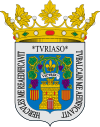Tarazona
| Tarazona municipality | ||
|---|---|---|
 Tarazona with Plaza de toros and cathedral
|
||
| coat of arms | Map of Spain | |

|
|
|
| Basic data | ||
| Autonomous Community : | Aragon | |
| Province : | Zaragoza | |
| Comarca : | Tarazona y el Moncayo | |
| Coordinates | 41 ° 54 ′ N , 1 ° 43 ′ W | |
| Height : | 480 msnm | |
| Area : | 244.01 km² | |
| Residents : | 10,533 (Jan 1, 2019) | |
| Population density : | 43.17 inh / km² | |
| Postal code : | 50500 | |
| Municipality number ( INE ): | 50251 | |
| administration | ||
| Website : | Tarazona | |
Tarazona is a small town and capital of a municipality ( municipio ) with 10,533 inhabitants (as of January 1, 2019) in the Spanish province of Saragossa in the autonomous community of Aragon . The city is the seat of the Roman Catholic Diocese of Tarazona . The old town is recognized as a cultural asset ( Bien de Interés Cultural ) in the Conjunto histórico-artístico category .
Location and climate
Tarazona is located on the Río Queiles about 12 km (as the crow flies) northeast of the Sierra de Moncayo, which is a maximum of 2315 m high and about 86 km (driving distance) northwest of the provincial capital of Saragossa near the border with the Old Castilian province of Soria and the autonomous region of Navarra in one Height of approx. 480 to 500 m ; the lovely town of Borja is located approx. 22 km to the southeast. The climate is temperate to warm; Rain (approx. 465 mm / year) falls throughout the year, with the exception of the rather dry summer months.
Population development
| year | 1857 | 1900 | 1950 | 2000 | 2017 |
| Residents | 8,440 | 8,790 | 12,054 | 10,416 | 10,538 |
While the rural population steadily declined in the second half of the 20th century ( rural exodus ) as a result of the mechanization of agriculture , the abandonment of small farms and the resulting loss of jobs , the population of the small town remained largely stable.
economy
For centuries, the residents of the village lived directly or indirectly as self-sufficient or as traders, craftsmen and service providers from agriculture in the surrounding villages, which also included livestock. In the 19th and 20th centuries Tarazona became an important manufacturer of matches and textiles , which, however, fell victim to a structural change that began in the 1980s. Today fruit tree plantations and viticulture in the area as well as tourism play important roles in the economic life of the place; holiday homes (casas rurales) are also rented.
history
During the Roman Empire , the former Turiaso was a prosperous city whose male residents had had full Roman citizenship since the year 212 at the latest . The diocese of Tarazona was founded in the 5th century. In the 8th century Arab-Moorish armies advanced into the upper Ebro Valley; around 1120 the area was recaptured by Alfonso I of Aragón ( reconquista ) and Tarazona was again made the seat of a diocese. In the further course of the Middle Ages, the city acquired enormous strategic importance due to its location on the border between Castile , Navarre and Aragon . In the 14th century it was occupied by Castilian troops for nine years ( Guerra de los Dos Pedros ) ; the cathedral, especially its originally Romanesque cloister , was damaged.
During the late Middle Ages and early modern times, the urban population consisted of Christians , Jews, and Muslims . The Muslim presence can be experienced in the local architecture, the cathedral was later rebuilt in the Mudejar style. The city suffered a deep crisis when in the years after 1610 the “ Moriscos ” were expelled from Aragon.
From 1822 to 1833 the city and its surrounding area belonged to the newly created province of Logroño , known as the La Rioja region.
Attractions
The small town has numerous monuments from the different epochs of the city's history:
- The construction of the cathedral of Tarazona , designed in the French Gothic style , began in the 12th century. It was consecrated in 1232, but later added repeatedly. The brick tower dates from the 16th century.
- Numerous other churches and convents bear witness to the importance of the Roman Catholic Church in the Middle Ages and in the early modern period. The Iglesia de la Concepción de Nuestra Señora has an exceptionally decorative Mudejar tower.
- The three-storey town hall (Casa consistorial) is located in the former commodity exchange (lonja) , an imposing Renaissance building with balconies and a loggia on the upper floor.
- The bullring (Plaza de Toros) , built on an octagonal floor plan in the late 18th century, is one of the oldest in Spain.
Town twinning
Since 1993 there has been a twinning between Tarazona and the French city of Orthez in Aquitaine .
Personalities
- Prudentius of Tarazona (around 550 – around 610), Bishop of Tarazona and saint
- Attila of Zamora (around 850 – after 920), first bishop of Zamora
- Antonio Guarás (1520–1579), Philip II's ambassador to Elizabeth I of England from 1571 to 1578
- Francisco Martínez Soria (1902–1982), Spanish actor
Web links
- Comarca de Tarazona y el Moncayo (Spanish)
- Article of the Diocese of Tarazona in the Catholic Encyclopedy
Individual evidence
- ↑ Cifras oficiales de población resultantes de la revisión del Padrón municipal a 1 de enero . Population statistics from the Instituto Nacional de Estadística (population update).
- ↑ Tarazona - climate tables
- ^ Tarazona - population development
- ↑ Tarazona - History
- ↑ Tarazona - Buildings


